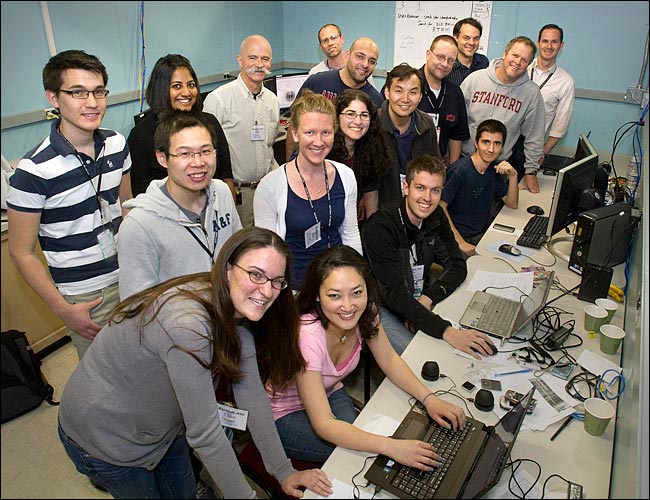Crystallography Users Learn Remote Data Collection Ahead of Shutdown
July 13, 2012
During this year’s annual RapiData course, hosted in April at NSLS by the Protein Crystallography Research Resource (PXRR), a group of students participated in a remote data-collection training workshop, the first of its kind at the facility. The workshop was motivated by the need to diversify the data-acquisition options of more than 800 NSLS crystallography users, who work at the five PXRR beamlines as well as beamlines X4 and X6. The project was conceived to allow users in this active field to have synchrotron access during the “dark period,” the time between the end of operations at NSLS and the start of those at NSLS-II.

The participants and instructors of the remote data collection workshop with lead organizer Alexei Soares (back row, middle).
Participants learned how to gather data remotely from specimens thousands of miles away at the Stanford Synchrotron Radiation Lightsource (SSRL). The workshop was jointly organized by PXRR and the Structural Molecular Biology group (SMB) at SSRL.
The prospect of a dark period is a challenge for crystallographers because these experiments yield time-critical data. One example is research in human-health-related medications and therapies. NSLS is scheduled to shut down in September 2014 and the crystallography beamlines being developed by the ABBIX Project (Advanced Beamlines for Biological Investigations with X-Rays) are not scheduled to come into operation until September 2015.
With all of this in mind, according to NSLS beamline scientist Alexei Soares, PXRR and SMB decided to be proactive and to start early training for remote access. “We wanted to give users this option,” said Soares.
The workshop trained 12 people, whose specimens were sent to SSRL ahead of time. SSRL sent staff scientists Graeme Card and Clyde Smith, who sat students in a small computer room, where they took remote control of operations at an SSRL beamline during data-collection sessions.
The workshop yielded excellent results. Of the 24 protein structures that were solved during RapiData, eight were solved via remote data collection. Moreover, the 16 participants gained knowledge that they will pass on to their peers at their home institutions. “This peer-to-peer principle was built into the program from the start, since it would be impractical to train all 800 crystallography users,” Soares said.
SSRL is an ideal “sister synchrotron” for this project for several reasons. It has a world-leading remote-access program with a proven record in easily and smoothly accommodating users across the country and around the globe. Equally important is that SSRL has expanded their capabilities enough to handle a significant number of new users. While other synchrotrons will certainly contribute towards users’ needs during the NSLS-II transition, SSRL’s expertise with remote users and the ability to handle new users made that facility a leading choice for this remote-user support initiative.
Next year, PXRR/SMB will host a second training course during RapiData. Interested students can apply for participation in RapiData 2013 beginning in the fall.
Workshop Participants
- Shulin Ju, Brandeis University
- Chloe Adams, University of Vermont
- Oriana Fisher, Yale University
- Judy Meissner, Brown University
- Haytham Abdelgawwad, University of Montreal
- Igo Petrik, University of Illinois
- Jeffrey Bacon, Boston University
- Han Han, University of Utah
- Steve Mayclin, National Institutes of Health
- Shasha Ji, Boston University
- Ash Prakash, University of Vermont
- Paul Heron, University of Montreal
2012-3229 | INT/EXT | Newsroom









